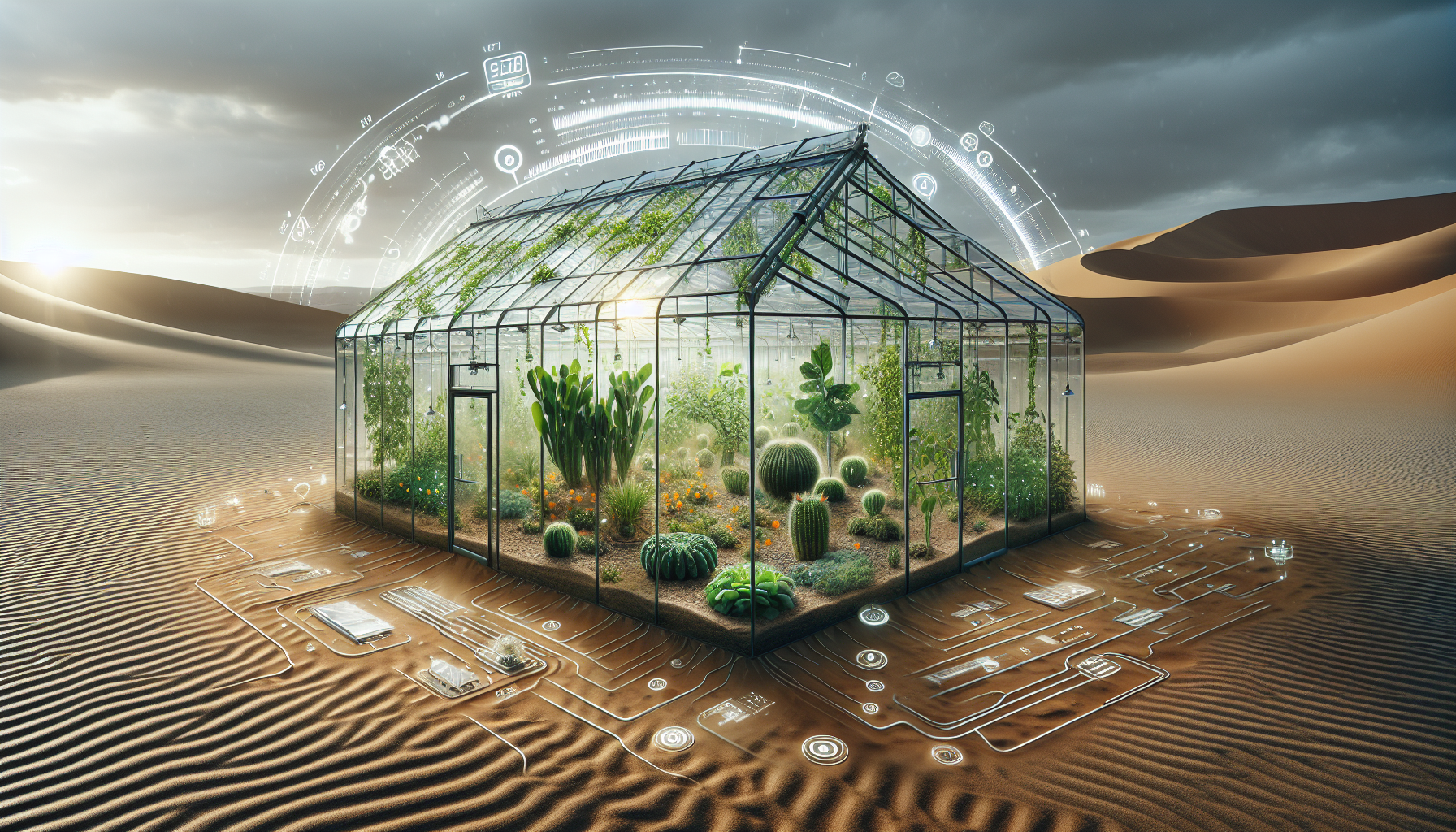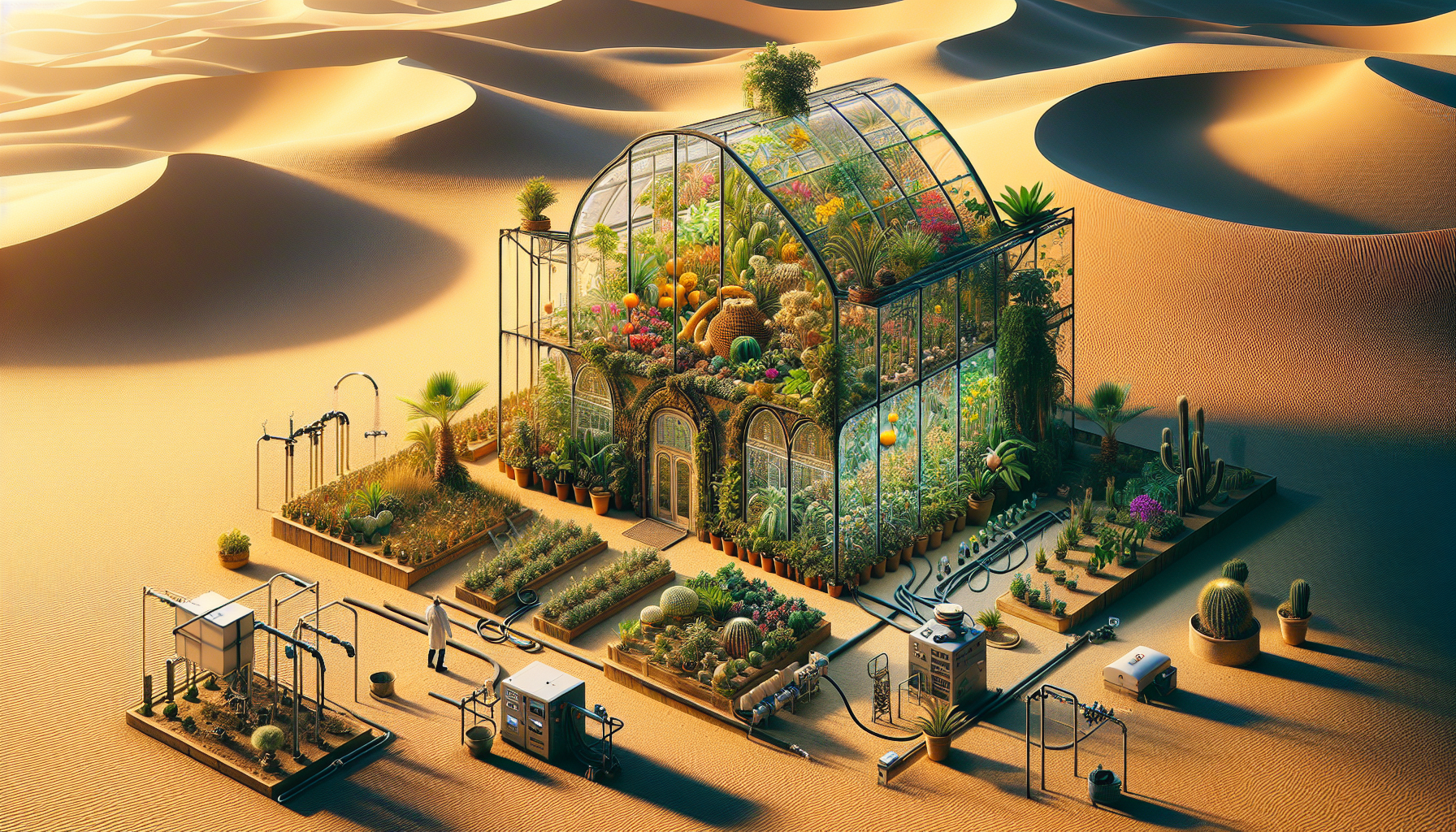
Imagine the lush green foliage, vivid floral hues and aromatic herbs flourishing right in the heart of the desert, defying all odds, thanks to the ingenious approach of greenhouse gardening. The article “Mastering Greenhouse Gardening in the Desert,” holds the secrets to creating this miniature oasis amidst the sand dunes. Through its pages, you’ll explore how to harness the sun’s might in your favor, employ desert-hardy plants and master greenhouse techniques tailored to beat the scorching heat. So let’s venture into this compelling journey, turning the seemingly impossible into a fruitful reality!

Understanding the Desert Climate
To truly master greenhouse gardening in the desert, you first need to get a grasp on what makes the desert climate unique. Comprehending the specificities of this environment will help you develop a successful gardening strategy for such arid regions.
Characteristics of Desert Weather
Desert weather is notable for its extreme conditions and minimal rainfall. During the day, desert temperatures can soar to incredible heights, while at night they can drop drastically. It’s these dramatic fluctuations, as well as typically low humidity levels, that can make gardening in such climates quite a challenge.
Challenges of Growing in Arid Conditions
Aside from temperature fluctuations and low humidity, desert climates also grapple with low soil fertility and limited water availability. The significant sun exposure can also put plants at risk of sunscorch, while the dry air can expedite moisture evaporation from both plants and soils.
Temperature Extremes and Their Impact on Plant Life
These extreme temperature variations can be tough on plants, from inhibiting seed germination to damaging mature plants. Further, the intense heat can disrupte photosynthesis process and prompt plants to lose water faster than they can absorb it, leading to wilting or even death.
Essentials of Greenhouse Design for the Desert
Creating a desert greenhouse that successfully negates these challenges requires thoughtful design and careful material selection.
Materials and Structure for Heat Management
Your choice of materials can significantly affect heat management within the greenhouse. Using materials with a high thermal mass such as stone or water barrels, can help stabilize greenhouse temperatures by absorbing heat during the day and releasing it during the cool desert nights.
Incorporating Ventilation Systems
A well-designed ventilation system is crucial to regulating temperature and humidity levels inside your greenhouse. Roof vents, side vents, and fans can work together to ensure effective cross-ventilation, balancing the temperature and decreasing excessive humidity buildup.
Shading and Cooling Mechanisms
Shading can play a significant role in temperature control by reducing the amount of direct solar radiation reaching your plants and thus lowering the overall greenhouse temperature. This can be achieved either by using shade cloths or installing internal shade systems.
Insulation Techniques for Night-Time Temperature Drops
Insulation is key to preventing heat loss during the chilly desert nights. Using double-walled panels or bubble wrap can enhance insulation, as can employing a thermal curtain system that can be drawn down for the night.
Water Conservation Strategies
Water is a precious resource in arid locations, so your greenhouse should employ smart water conservation methods.
Efficient Irrigation Systems
To maximize your water efficiency, you might opt for a variety of irrigation systems such as soaker hoses or wicking beds which deliver water directly to your plants’ roots, minimizing evaporation.
Rainwater Harvesting Methods
Rain may be infrequent in the desert, but when it does occur, you can take advantage by setting up a rainwater harvesting system. Collected water can be stored for use during dry spells.
Utilizing Drip Irrigation for Water Savings
Drip irrigation is an excellent water-saving technique that precisely delivers water to the root zone, thus reducing overwatering and runoff. Moreover, it can be paired with a timer system to provide consistent and controlled watering.
Recycling Water Within the Greenhouse
A closed-loop system lets you capture, filter, and reuse water within your greenhouse. This could involve catching condensation or using graywater systems, effectively minimizing your water consumption.
Soil Preparation and Management
The native desert soil may be infertile, but there are ways to make it conducive for plant growth.
Amending Desert Soil
To improve the fertility and water-holding capacity of your desert soil, consider adding organic matter like compost or well-rotted manure. You may also want to introduce soil microbes that aid nutrient absorption.
Using Soilless Media
Soilless media such as hydroponics or coco coir can be a viable alternative in unfertile desert situations. These media contain all necessary nutrients for plant growth while maintaining good aeration and water-holding capacity.
Mulching to Retain Soil Moisture
Mulching can be an effective strategy for retaining soil moisture and preventing evaporation. Mulch materials like straw, wood chips, or compost can be spread around plants to form a protective barrier against the harsh desert sun.
Soil Testing and Nutrient Management
Regular soil testing is essential for determining nutrient deficiencies and understanding the soil’s pH. From there, you can develop a comprehensive nutrient management plan to replenish the soil and foster healthy plant growth.

Selecting the Right Plants for Desert Greenhouses
The right set of plants can make a big difference in your desert greenhouse’s success.
Heat-Tolerant Vegetable Varieties
Vegetables such as tomatoes, peppers, and eggplants are naturally heat-tolerant and can thrive in a desert greenhouse setting. These vegetables can deal with high daytime temperatures while producing a bountiful harvest.
Drought-Resistant Flowering Plants
A variety of flowering plants have adapted to become drought-resistant, surviving and even thriving under minimal water conditions. These include lavender, sedum, and echinacea, which can add color and beauty to your greenhouse.
Growing Exotic Plants in Controlled Environments
Your desert greenhouse can be a nurturing sanctuary for exotic plants that wouldn’t usually survive in arid conditions. From orchids to bird of paradise, these plants can flourish under your watchful care.
Understanding Plant Hardiness and Adaptability
Different plants have different hardiness zones – this is the measure of a plant’s ability to survive in specific conditions. Understanding this, and choosing the right plants for your desert environment, will go a long way in ensuring your greenhouse’s success.
Maintaining Optimal Growing Conditions
Once your greenhouse is established, it’s important to continually monitor and manage your plants’ environment to maintain ideal conditions.
Controlling Temperature and Humidity
Artificial heating and cooling structures, automated ventilation, and shading mechanisms can help maintain optimal temperature ranges. Simultaneously, humidity levels can be managed by appropriate watering schedules, ventilation, and the use of humidity controllers.
Providing Adequate Lighting
In winter months or for plants requiring lower light intensity, shading mechanisms can be used to control light levels. And for those requiring higher light levels, supplemental lighting systems may be necessary.
Managing Plant Nutrition and pH Levels
A consistent feeding schedule, complemented by routine soil testing, will ensure your plants have the nutrients they need. Proper management of pH levels – either in the soil or your chosen growth medium – will ensure that these nutrients are readily available to your plants.
Preventing Plant Stress Factors
Too much heat, cold, light, or nutrient imbalance can stress your plants and make them susceptible to pests and diseases. Regular monitoring and timely adjustments can keep stress factors at bay.
Pest and Disease Management in Harsh Climates
Given the closed environment of a greenhouse, pest and disease outbreaks can quickly spiral out of control. It’s therefore crucial to have preventive and control strategies in place.
Common Pests in Desert Greenhouses
Common desert greenhouse pests include aphids, whiteflies, and spider mites. Being familiar with these can help you identify and quickly address an infestation.
Strategies for Organic Pest Control
By introducing beneficial insects and using botanical insecticides, you can keep pests in check without resorting to toxic synthetic pesticides. Strategies such as crop rotation and employing plant varieties with natural pest resistance can further fortify your fight against harmful pests.
Preventing Disease Spread in Closed Environments
Strict hygiene protocols inside and outside the greenhouse can prevent the spread of diseases. This encompasses cleaning tools and equipment as well as regularly inspecting plants for signs of illness.
Regular Monitoring and Proactive Measures
With consistent monitoring, you can promptly spot any signs of pests or diseases. Proactive measures such as quarantining affected plants and applying treatments early can keep small issues from escalating.
Technological Innovations in Desert Greenhouse Gardening
Modern technology has opened up exciting possibilities for desert greenhouse gardening, making it simpler and more efficient.
Automation in Greenhouse Operations
Automated systems can control everything from vent position to irrigation scheduling, and even lighting. Using automation can ensure consistency in your greenhouse environment and save you time and effort.
Climate Control Technologies
Advanced climate control technologies help maintain ideal temperature, humidity, and CO2 levels. These systems can even be programmed to adjust these variables according to the time of day or the growth stage of your plants.
Advanced Hydroponic and Aquaponic Systems
Hydroponics and aquaponics provide advanced soilless growing methods, using nutrient-rich water solutions or fish waste to nourish plants. These systems are highly water-efficient and can yield significantly higher outputs as compared to traditional soil-based cultivation.
Use of Artificial Intelligence for Plant Monitoring
Artificial Intelligence (AI), combined with sensors and cameras, can monitor plant health and provide timely alerts for any detected issues, making the monitoring process faster and more accurate.
Energy Efficiency and Sustainable Practices
An energy-efficient and sustainable greenhouse can drastically cut down your operational costs, leaving a smaller footprint on the environment.
Solar Power Integration
Take advantage of the ample desert sun by integrating solar power into your greenhouse. Solar panels can power your heaters, cooling systems, lights, or any other electric equipment.
Utilizing Energy-Efficient Equipment
Opt for energy-efficient equipment such as LED lights, energy star-rated heating and cooling systems, and efficient water pumps to reduce your energy consumption.
Sustainable Material Choices for Construction
Choosing sustainable and locally sourced materials for your greenhouse – like wood or recycled plastic – can minimize your environmental impact. These materials are often more resilient, easier to replace, and help maintain a natural aesthetic within your greenhouse.
Long-term Sustainability Planning
By planning for sustainability from the get-go, you can ensure a future-ready greenhouse. This includes considering your water sourcing and waste management as well as your energy sourcing and conservation strategies.
Case Studies and Success Stories
Many gardeners have successfully mastered the art of desert greenhouse gardening. By looking at these case studies, you can gain inspiration and valuable insights.
Innovative Desert Greenhouse Projects Worldwide
Across the globe, there have been several innovative projects that have turned the challenges of desert gardening into opportunities. These projects have used ingenious design techniques, advanced technologies, and sustainable strategies to create flourishing desert greenhouses.
Lessons Learned from Successful Desert Farms
Successful desert greenhouse growers have shared their lessons learned – from choosing the right plants to implementing efficient irrigation systems. Their experiences offer invaluable tips and practical advice for establishing and growing your own desert greenhouse.
Adaptation and Evolution of Desert Greenhouse Practices
Over time, desert greenhouse gardening has evolved and adapted to overcome various challenges. By understanding these changes, and the reasons behind them, you can be better prepared to adapt and evolve your own practices.
Future Outlook of Desert Greenhouse Gardening
The future of desert greenhouse gardening looks promising with the proliferation of new technologies and the increased emphasis on sustainable practices. By continually learning and staying updated, you can make sure your desert greenhouse stays successful in the years to come.
In conclusion, mastering greenhouse gardening in the desert involves understanding the desert climate, designing a suitable greenhouse, conserving water, preparing the soil, choosing the right plants, maintaining optimal conditions, managing pests and diseases, embracing technological innovations, practicing energy efficiency, and learning from others’ experiences. By considering these factors, you can create a thriving desert greenhouse that benefits you, your plants, and the environment.

